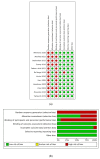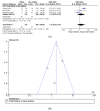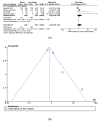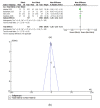Comparative Analysis of Morbidity and Mortality Outcomes in Elderly and Nonelderly Patients Undergoing Elective TEVAR: A Systematic Review and Meta-Analysis
- PMID: 37568406
- PMCID: PMC10420243
- DOI: 10.3390/jcm12155001
Comparative Analysis of Morbidity and Mortality Outcomes in Elderly and Nonelderly Patients Undergoing Elective TEVAR: A Systematic Review and Meta-Analysis
Abstract
Objective: Due to an ever-increasing ageing population and limited available data around the use of thoracic endovascular aortic repair (TEVAR) in elderly patients, investigating its efficacy and safety in this age cohort is of vital importance. We thus reviewed the existing literature on this topic to assess the feasibility of TEVAR in elderly patients with severe thoracic aortic pathologies.
Methods: We identified all original research studies that assessed TEVAR in elderly patients published up to 2023. Morbidity, as assessed by neurological and respiratory complications, endoleaks, and length of stay, was the primary endpoint. Short-term mortality and long-term survival were the secondary endpoints. The Mantel-Haenszel random and fixed effects methods were used to calculate the odds ratios for each outcome. Further sensitivity and subgroup analyses were performed to validate the outcomes.
Results: Twelve original studies that evaluated elective TEVAR outcomes in elderly patients were identified. Seven studies directly compared the use of TEVAR between an older and a younger patient group. Apart from a shorter hospital stay in older patients, no statistically significant difference between the morbidity outcomes of the two different cohorts was found. Short-term mortality and long-term survival results favoured the younger population.
Conclusions: The present meta-analysis indicates that, due to a safe perioperative morbidity profile, TEVAR should not be contraindicated in patients based purely on old age. Further research using large patient registries to validate our findings in elderly patients with specific aortic pathologies and both elective and emergency procedures is necessary.
Keywords: TEVAR; age; elderly; endovascular repair; morbidity; mortality; thoracic aorta.
Conflict of interest statement
The authors declare no conflict of interest.
Figures









References
-
- Czerny M., Funovics M., Ehrlich M., Hoebartner M., Sodeck G., Dumfarth J., Schoder M., Juraszek A., Dziodzio T., Loewe C., et al. Risk Factors of Mortality in Different Age Groups After Thoracic Endovascular Aortic Repair. Ann. Thorac. Surg. 2010;90:534–538. doi: 10.1016/j.athoracsur.2010.03.096. - DOI - PubMed
Publication types
LinkOut - more resources
Full Text Sources

